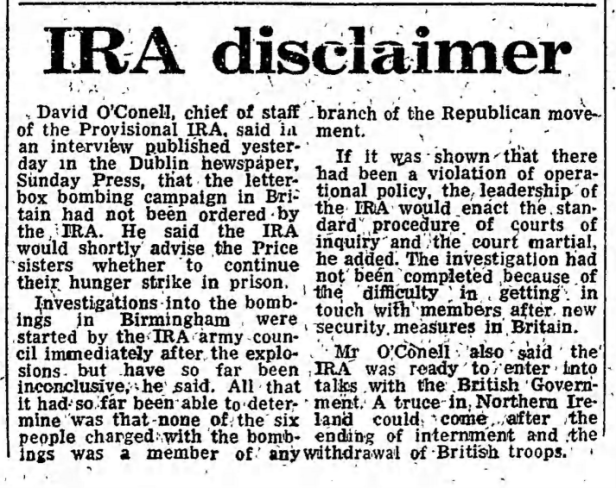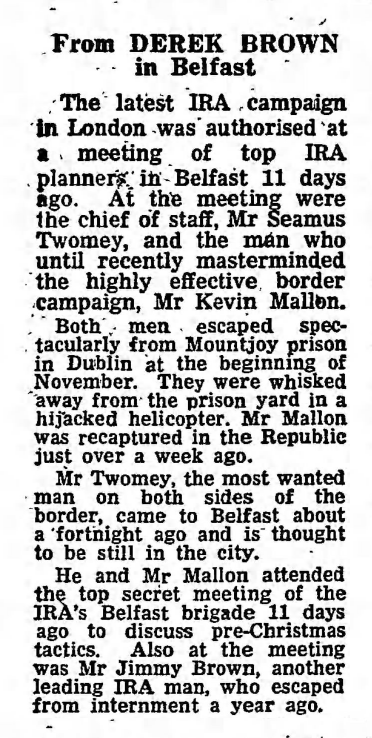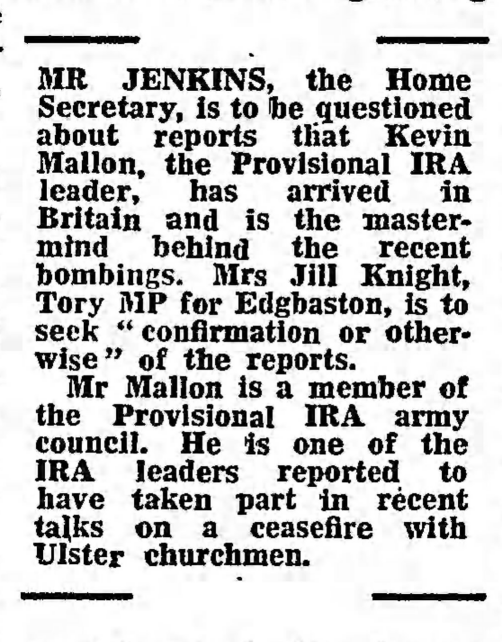Kieran Conway was billed as a former IRA GHQ Director of Intelligence who was willing to participate in the Birmingham Pub Bombings’ Inquest on various conditions:
- He would only speak via video link from an unidentified location (presumably in Dublin) hiding behind the Irish border he fought so hard to remove.
- He would not identify any living IRA volunteer related to the Birmingham Pub bombings.
- He would only repeat names of IRA volunteers previously published and associated with the bombings.
- He stated that he believed the claim that bomber Mick Murray could not find a working telephone box in time to give a warning that might have saved lives.
- He did not believe that Murray intended to kill civilians.
- The only information he was willing to offer was the unsubstantiated claim that two figures he identified as members of the IRA’s Army Council (David O’Connell & Kevin Mallon) were upset by the bombing.
- He implied that the bombing was not authorised by the IRA Army Council.
The tabloid press did not highlight that Conway had been in prison in Northern Ireland for three years (after his arrest in Derry in November 1971) and had only been released a few weeks before the Birmingham Pub bombings occurred.
According to his recently published book, it was some time after his release and his return to Dublin and to his family that he got the news that he was to set about creating an intelligence unit for IRA GHQ, a task he later described as a failure because
“the IRA was irredeemably localist and short-termist with little use for a centrally organised intelligence system, and certainly not one based in Dublin, so far from the conflict. In addition, the operations people did their own intelligence, making my own department even less relevant to the Army’s real needs.”
Conway claimed that Mick Murray and his IRA comrades in Birmingham had not intended to kill civilians, but in his book Conway wrote:
“The campaign in England was stepped up that autumn with the first of a series of no-warning bombs in bars frequented by British soldiers, and of course civilians as well, in what was a clear change in operational policy. In early October four soldiers, all in their teens and two of them women, were killed, together with a civilian, when a bomb exploded at a pub in Guildford. More explosions occurred at ex-servicemen’s clubs in London and at the Conservative Party’s Birmingham headquarters before a bomb was tossed into a pub in Woolwich, killing a soldier and the civilian barman and injuring many others.
Off-duty soldiers were targets and they knew they were targets, and, back then, I had little sympathy for either the soldiers or the unfortunate civilians who had been sharing their drinking space.”
Conway knew absolutely nothing about the various changing patterns of the IRA’s bombing campaign in England since March 1973 during which period the IRA bombers had given warnings, had given no warnings or else had given misleading warnings and had injured or killed many civilians.
Many IRA bombs in Northern Ireland had most definitely massacred civilians since 1972.
The IRA’s Bomb Warning Code-word
Conway did not tell the inquest that IRA bomber Mick Murray used a very secret IRA code-word when he finally telephoned a belated warning to a newspaper only 15 minutes before the bombs exploded in Birmingham.
This use of the particular code-word absolutely proved that he and his unit were operating on behalf of the IRA’s GHQ person responsible for all bombings in England – the code-word was “Double X” and I had set up that code-word myself 16 months before in London.
I had conveyed that code-word directly back to the IRA’s GHQ person responsible for the entire bombing campaign in England. It was a closely guarded secret to prevent its misuse.
Murray used it. There was no possibility that his IRA activity was unknown to the IRA GHQ staff and nor was there any possibility that he was not in contact with the IRA’s GHQ staff.
The problem with Murray and the code-word was that he used it when giving a warning to a Birmingham newspaper only 15 minutes before the bombings – a deliberately inadequate warning designed to inflict maximum casualties and then lay as much blame as possible on the police.
Telephones Vandalised?
Kieran Conway sought publicity from the Birmingham Pub Bombing’s case without having done his homework. He backed up bomber Mick Murray’s claim that he was unable to find telephone kiosks that were not vandalised until 15 minutes before the bombs exploded.
Mick Murray lied.
Two members of the ill-fated Birmingham Six were in New Street railway station awaiting the train to Belfast (the boat train) which they boarded at 7.55pm – 35 minutes before Murray’s bombs exploded nearby.
One of them, Gerry Hunter, used a fully-working phone box on two occasions in New Street station at approx. 7.10pm and again at 7.35pm to call a friend in ‘The Bone’ in Belfast to ask about being collected when they docked in Belfast port. One of the two calls was witnessed by a second member of the Birmingham Six, Billy Power.

This evidence was presented at the trial of the Birmingham Six by Gerry Hunter and the recipient of the call in Belfast attended the trial and gave evidence.
Copies of the legal depositions of the Birmingham Six were later re-printed in a booklet entitled ‘The Birmingham Framework” by Frs. Denis Faul and Raymond Murray from which the following excerpt from Hunter’s evidence (about using the phone boxes twice in New Street) is taken:

New Street station would have provided Mick Murray with the easy opportunity and anonymity to make the warning calls only minutes after the bombs were planted, thereby allowing almost a full 55 minutes of warning. The station was very close to where he had planted the bombs and there were three or four phone boxes together from which to choose.
Instead, Murray traveled to a pub 30 minutes away and phoned a warning to a newspaper only 15 minutes before the bombs were due to explode.
Murray’s actions were calculated to cause an atrocity in Birmingham and also to denigrate the police for allegedly failing to act in time.
Kieran Conway also repeated the laughable claim that David O’Connell had instigated an inquiry into the bombings which might possibly have brought about a court martial and punishment for the bombers if they had been judged to have acted outside the IRA’s code. What code?
After the Claudy bombings, after Coleraine, after Bloody Friday, not a single IRA bomber was ever anything but celebrated by the IRA Army Council.
Conway’s Smokescreen Protecting Whom?
Conway was producing a smokescreen when he only quoted the IRA Army Council’s David O’Connell in relation to any IRA actions in late 1974.

David (or ‘Daithi’) O’Connell, a married man, had been literally caught with his pants down in October 1971 when he brought a very young IRA woman, Maria McGuire, around Europe on an arms’ buying trip for the IRA.
After newspapers named him and reported his activities in Amsterdam, he escaped back to Dublin with McGuire and faced allegations that he was having an affair with her.

Over a year later, Maria McGuire fled to London and wrote a tell-all book about O’Connell and the IRA after she became disaffected by the horror of mass-casualty IRA bombings in Northern Ireland and in particular by the ‘Bloody Friday’ bombings in Belfast.
Republicans claimed that she had been a British agent all along and that O’Connell had embarrassingly fallen for a British Intelligence honey-trap.
As a result, O’Connell’s IRA military influence dimmed very rapidly and although he was kept on as a Scarlet Pimpernel political figurehead who appeared under the noses of police and soldiers at various republican demonstrations in Northern Ireland – and who drank copious amounts of whiskey in John Hume’s house in West End Park in Derry where he often stayed – his knowledge of the military side of the IRA was in decline. He was good for making statements to the Press, however.
O’Connell gave an interview to journalist Mary Holland on London Weekend Television on 17th November, 1974, three days after IRA man James McDade had blown himself up with his own bomb at Coventry Telephone Exchange and four days before the Birmingham Pub Bombings, and a part of the transcript is shown below:

Sandwiched between McDade’s death and the Birmingham Pub Bombings, O’Connell’s rare television interview would have had clearance by the entire IRA Army Council and O’Connell was evidently briefed to give dire warnings aimed at the British government but in reality aimed at the British public who were more accessible to the IRA than government ministers.
Above all, IRA volunteers in England would have watched or read about this interview by their Chief of Staff and taken the hint about escalation, even if orders had not already been communicated to them by IRA GHQ back in Dublin to escalate the campaign.
However, proof that O’Connell’s militarist colleagues on the IRA Army Council were not telling him what was actually going on came to light when O’Connell released a statement to the press on December 2, 1974 – a week or so after the Birmingham bombings – claiming that the IRA’s London letter-bomb campaign was NOT the work of the IRA and that he was uncertain about who carried out the Birmingham Bombings.

Meanwhile, IRA Army Council militarists were briefing journalists that the letter-bomb campaign and all of the other associated bombs in London, Bristol and elsewhere WERE INDEED the work of the IRA.
Conway’s smokescreen was covering for somebody else in the IRA.
One of the chief militarists on the IRA’s Army Council during 1973 and 1974 was someone who was regularly named in the press along with his rank on the IRA Army Council – he was Kevin Mallon, so important to the IRA Army Council that the IRA orchestrated a helicopter escape from prison for him.

He or people close to him could not help themselves when it came to blabbing to journalists. On December 19, 1973, The Guardian’s Derek Brown reported:

Mallon was so well-publicised during this period that shortly after the Birmingham Pub Bombings he was rumoured to be in London and The Guardian reported the scare on December 20, 1974:

In August, 1974, Mallon had been named in the press as the man in charge of the bombing campaign in England:

Who was this Kevin Mallon?
In his book, Kieran Conway described meeting Kevin Mallon as a love-at-first-sight story:
“At …meetings in Donegal, I met up again with Pat Doherty and various others whom I had known in 1971. I also met Kevin Mallon for the first time. Mallon was the third man on the helicopter escape and perhaps the most important IRA figure then not in prison. He had been recaptured in December – typically at a dance near Portlaoise with some gunplay involved – but had again escaped when he was among the eighteen who had blasted their way out of Portlaoise prison the previous August. At this time he would have topped the wanted list along with Twomey and O’Connell.
Then in his mid-30s, Mallon was a hard-drinking, hard-talking, seriously hard man with buckets of charisma and an unrivalled capacity to motivate people. He was the closest thing the modern IRA had to a Michael Collins and I was completely bowled over by him. He was on the run and always armed.
Mallon was a tough and occasionally ruthless user of people, though those who worked for him adored him. But while he could control his people, the special-forces feel he fed in them – the virtual contempt for the rest of the Army – meant that discipline fell away once he was arrested and these individuals pretty much did as they pleased.
Though the leadership went through various changes in personnel during the early 1970s, escapes and the then relatively short sentences handed down in the South for membership allowed Twomey, Ruairí Ó Brádaigh, Joe Cahill, J.B. O’Hagan, Brian Keenan and Kevin Mallon to remain at its core.
Shortly before the truce was declared Kevin Mallon was arrested in south Dublin… Mallon’s removal was a disaster for the Army, in that it removed the key hard man who could have carried the truce through the summer, or had it killed off more decisively than was to actually occur. It also led, in time, to a group of his people spiralling out of the leadership’s control as the ceasefire became less popular.
Kevin Mallon used to tell a (possibly apocryphal) tale against himself about how a GHQ directive had arrived in Tyrone to the effect that any volunteer making shapes at a prisoner’s wife was to be kneecapped. As he told the story, he and his second in command had contemplated each other’s kneecaps at considerable length before deciding to quietly ignore the directive.”
So Kieran Conway bluffed his way into the Birmingham Pub Bombings’ inquest with the intention of telling the inquest absolutely nothing of any use in uncovering the truth about the Birmingham Pub Bombings and managed to avoid mentioning an IRA leader who was regularly written up in the press in the early 1970s as the man in charge of the bombing campaign in England, and with whom he almost fell in love…

Mallon was not one to avoid having his picture taken for the historical record…

And it’s not as if in the early 1970s that prominent IRA Army Council members and hangers-on weren’t drinking with and briefing journalists – buoyed up by the 1972 ceasefire talks with William Whitelaw in Cheyne Walk, Chelsea, they thought they were going to win the “war” shortly afterwards and wanted a full record of IRA activities in the press.
Journalists from The Irish Press Group newspapers and The Guardian were favoured clients at the time:

Everybody appeared to know who was doing what on the IRA Army Council except the police!
So, why did Kieran Conway offer to participate in the Birmingham Pub Bombings’ inquest, by remote video link from Dublin, when he had nothing to offer either from his own patchy recollections or from the public record which he had not bothered to research?
The IRA Army Council leader best placed to explain the IRA’s bombing campaign in England in the 1970s is the IRA’s truest 26-county fighter hero Kevin Mallon, now living in Howth, County Dublin.
Kevin, have you nothing to say to the relatives of the victims of your Birmingham Pub Bombings?
You spoke openly to the Protestant churchmen who were the smokescreen to make the 1974/75 ceasefire more palatable to the general public, even though the actual arrangements for that ceasefire were happening months before any Protestant churchmen were involved.
Can you not speak now to the Birmingham victims?

The one man who has all the answers about all of the IRA’s bombings in England – Kevin Mallon – and nobody is asking him any questions!

It’s difficult to comprehend why the Birmingham Pub Bombings’ inquest allowed Conway to participate when it was known in advance that he was not going to give any information relevant to its deliberations.
Has anyone in the Birmingham Pub Bombings’ inquest actually heard of Kevin Mallon?
Kevin is visible in the red shirt accompanying wanted bomber Evelyn Glenholmes in Dublin in 1986 as Gardai try to arrest her for extradition proceedings (Martin McGuinness and Gerry “Nivver a Member” Adams trotting along beside):
Maria McGuire offered an interesting explanation of her decision to defect from the IRA and re-locate to London in the early 1970s:
For an article on Witness ‘O’, click here.
For an article on an IRA volunteer who told the truth, click here.

